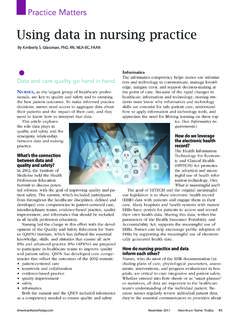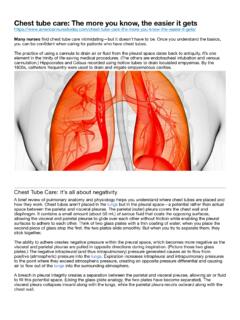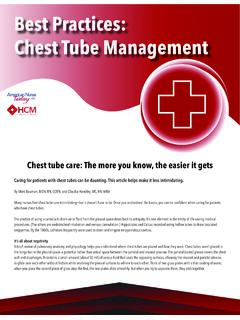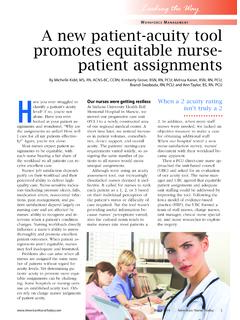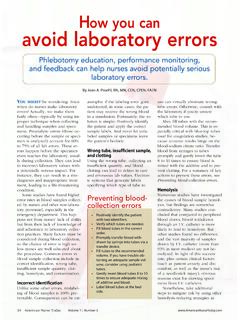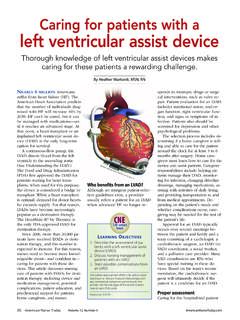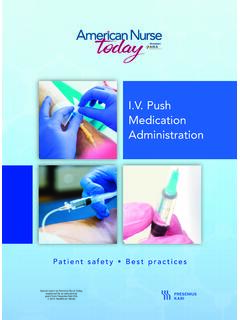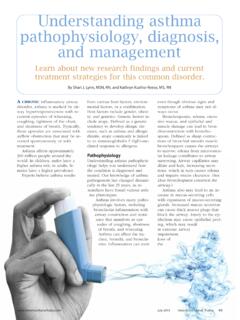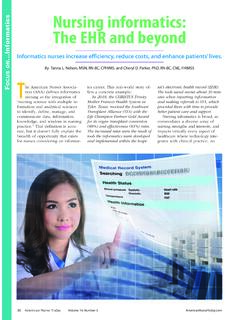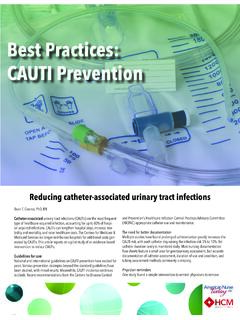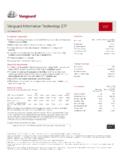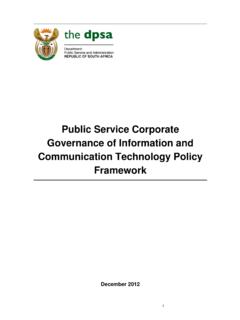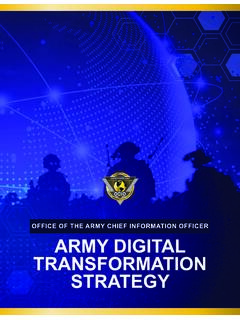Transcription of Nursing, Technology, and Information Systems
1 SP E C I A LRE P O RT:Nursing, technology , and Information SystemsThis special report is sponsored by Cerner Corporation and the Healthcare Information and Management Systems Society (HIMSS). All articles contained in this special report have undergone peer review according to American Nurse Nurse TodayVolume 8, Number of this article appear inAmerican Nurse Today (UnitedStates) and Nursing Times(Unit-ed Kingdom) to acquaint readerswith common goals, challenges,and advances in using health in-formation technology to enablenurses to provide safer and moreefficient care. Around the globe, inevery setting, nurses seekto provide care to pa-tients and families to keep themsafe, help them heal, and returnthem to the highest possible lev-el of functioning. Nowhere is thestruggle to achieve these simpleaims more apparent than inhospitals.
2 The tightrope of bal-ancing what nurses believe to beadequate resources for high-quality care and the affordabili-ty of these required resources areoften at odds. Disagreementamong leaders in healthcare de-livery Systems as to how to allo-cate nursing resources has led totension and discord. Despitedecades of research showing thatthe amount of care provided byregistered nurses directly affectsmortality and morbidity, nurseleaders continue to have to justi-fy requests for nursing , the desire tomake care more affordable hasfueled efforts to make care moreefficient and effective. The publicrecognizes this means examin-ing all aspects of care in the pur-suit of cost-reduction measuresthat will not reduce quality. Inthe United States, nurses contin-uously rank as the nation s mosttrusted professionals by theGallup Poll and have the pub-lic s support whenever belt-tight-ening issues come to the fore-front.
3 On the other hand, in theUnited Kingdom (UK), the de-bate over resources that hasbeen playing out in the mediahas caused confusion and publicuncertainty as to whom to be-lieve, undermining confidence inthe system as a whole. The nurs-ing profession hasn t beenspared this negative view andhas needed to reassure the pub-lic of its core values and pur-pose that caring and compas-sion are part of the core businessof is what nurses do,and what nurses do is coordi-nate and deliver care. So al-though the context, Technology, and health needs of our popula-tions have changed, nurses re-main the foremost providers andcoordinators of care. Why state something so obvi-ous? Showcasing the caring aspects of nursing in a techno-logically dominated world ischallenging. technology enablescare and enhances safety by au-tomating functions both simpleand complex.
4 It doesn t replacenurses. As one expert cautions,automation should occur innursing, not ofnursing. The val-ue of technology hinges on howit s used and whether it helps orhinders care. Changing nursing practicesafely So why do nurses have to strug-gle so hard to get the technologywe need to support our practice?And when this technology isavailable, why don t we reap theSPECIALREPORT: Nursing, technology , and Information SystemsEnabling the ordinary: More time to care Pamela F. Cipriano, PhD, RN, NEA-BC, FAAN, and Susan Hamer, DEd, MA, BA, RGN The value oftechnology inautomating andimproving patient care 2013 American Nurse TodaySR3benefits we ve been seeking forour practice? For years, many in the health-care community believed nurseswere too slow to embrace newtechnologies and might disruptor even obstruct the changeprocess.
5 Had they ever visited aneonatal or intensive care unit?Although their description ofnurses and nursing wasn t accu-rate, it had become a mantrawithin a wide variety of organi-zations. What they failed to grasp,and continue to misunderstand,are the practical realities of howprofessions change and how tosupport innovation in generations, nurses havechanged their practice success-fully and have adapted to newchallenges, such as coping withrising patient acuity, safely de-livering dangerous drugs, andpreventing adverse events. Andthey did this in a world wheremanagement theories were onlybeginning to address nursingand healthcare settings. At times, the need for changehas been critical and the re-sponse of the nursing professionhas been swift. Of course, wecan all acknowledge there areaspects of care we should havechanged but have resisted.
6 Nurs-ing professionals have sought tounderstand how to change ourpractice and increase the avail-able evidence on which to baseour care. We understand how tochange practice safely and howto sustain those changes. Shared vision fortechnology: Enhancing care The United States and UK sharesimilar goals for technology in-novation but differ in the eco-nomics and delivery-system con-figurations. (See Comparing and UK health Systems .) Withthe technology explosion, manyhealthcare organizations havesought to add new systemsrather than integrate existingones usually without knowingif the addition would increasethe workload or change workpractices or whether it would beacceptable to patients. Organi-zations supported technologyimplementation to achieve busi-ness goals, whereas nurses sawpractice development as the real goal.
7 The focus on the business caseaddressed primarily organiza-tional benefits, such as the de-sire for technology to replacestaff time and the ability to market to patients the use of cutting-edge devices and elec-tronic record Systems , not pa-tient experience and of these organizationstreated technology to help nurs-es deliver care as a separatecase, viewing it as an additionalcost to services rather than amechanism to enhance , the possibility of being un-able to sustain the technologywas always real. Increasingly, health technolo-gy projects have been seen asspecial projects that need specialteams set up by senior man-agers, some of whom are unfa-miliar with the care managers seem to strugglewith focusing on supportingfrontline practitioners to delivercare. Managers have failed re-peatedly to enable ordinary day-to-day care with technologies.
8 The need for technology tosupport practice was demonstrat-ed by findings from the Technol-ogy Drill Down project of theAmerican Academy of Nursing sWorkforce Commission. Frontlinenurses and other multidiscipli-nary care team members stressedthe importance of involving di-Comparing the and UK health Systems Despite some fundamental differences, healthcare delivery Systems in the UnitedStates and the United Kingdom (UK) share a national commitment to quality andthe role of nurses in improving care. In both nations, nurses are expanding the useof health Information technology tools to improve safety and efficiency andinvolve patients in their care. The chart below compares some features of the UK health StatesUnited KingdomPayer(s) Government Government Private insurance companies (National Health Service [NHS]) Self-pay Private insurance companies Private payers Delivery Hospital centric (government Strong community-based care systemor private)with primary-care focus Increasing shift toward Hospitals run by trusts illness prevention and more (public-sector corporations ambulatory, home, and providing services for the NHS)post-acute careTechnology Electronic health record Paperless system by 2018visionfor all citizens by 2014 Improved availability, Improved availability, quality, quality, and safety of and safety of informationinformationSPECIALREPORT.
9 Nursing, technology , and Information SystemsThe United States and UKshare similar goals fortechnology innovation butdiffer in the economics and Nurse TodayVolume 8, Number caregivers in technology de-sign, selection, and testing stepsoften overlooked in the haste ofacquiring Systems or devices. (SeeMaking care safer and more effi-cient with technology .) Technologies designed for andused by nurses at the point ofcare haven t always been easy touse. A recent international sur-vey seeking to identify prioritiesfor nursing informatics researchon patient care acknowledgesthat despite the growing evi-dence base on the design andevaluation of health informa-tion technology (HIT), thesetechnologies focus mainly onmedical practice. The studyfound that the two most highlyranked areas of importance werethe development of Systems toprovide real-time feedback tonurses and assessment of HIT seffects on nursing care and pa-tient outcomes.
10 Agenda for leadershipWe know how to support high-quality professional practice de-velopment and what conditionsenable professions to changerapidly. If a profession is encour-aged to annex new forms ofknowledge and opportunities, itcan rapidly develop appropriatepractice to self-adapt. This is theroute to successful, sustainableinnovation. Nurses must addressthe leadership challenge of howto respond to and accelerateadoption of technologies to sup-port practice. We need nurseleaders who see technologies aspromising solutions, not prob-lems, and are able to integratetechnology into their vision formeeting practice needs. Nurseleaders need to model and pro-mote examples of enabling tech-nologies and demand systemsthat meet practitioners needs. As technology matures, nursesand other healthcare profession-als should be able to collect in-formation only once and see itreused often.
